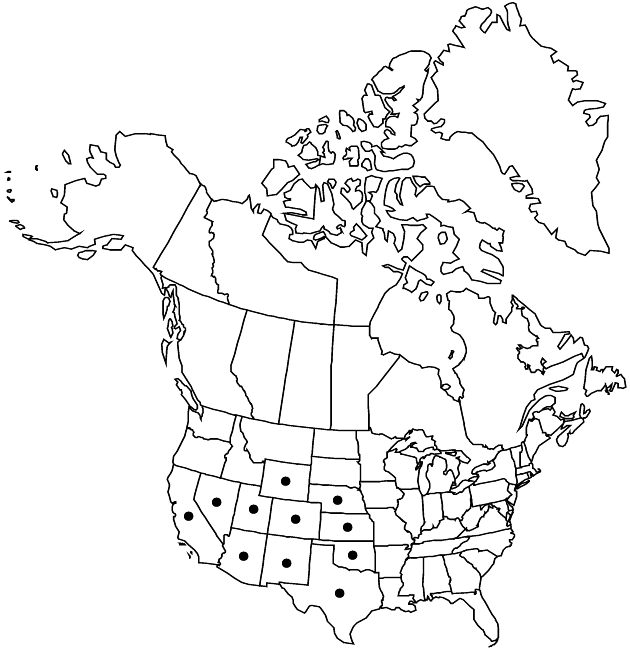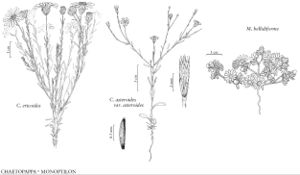Chaetopappa ericoides
Phytologia 64: 449. 1988.
Perennials, 6–12 cm, densely stipitate-glandular or eglandular; taprooted (usually not evident in collections), forming beds or clumps of large, separate tufts connected by underground rhizomes and caudexlike, scaly-leaved stems. Leaves even-sized, densely overlapping; blades linear-oblanceolate to lanceolate, 5–11 (–20) × 0.5–2 mm, coriaceous, bases not clasping (midnerves strongly raised, longitudinally 2-grooved adaxially), apices spinulose, faces usually densely, minutely, orangish stipitate-glandular. Involucres turbinate to hemispheric, (3.5–) 4.5–6 (–7) × 4–8 mm. Ray-florets (8–) 12–24; corollas white. Disc-florets 12–24, bisexual. Cypselae 1.7–3 mm, 5-nerved, faces strigose; pappi of (20–) 24–26 (–30) barbellate bristles in 1 series. 2n = 16, 32.
Phenology: Flowering (Mar–)Apr–Aug(–Nov).
Habitat: Open sites over shale, gypsum, igneous, limestone, roadsides, grassland, Larrea flats, juniper to pinyon-juniper woodlands
Elevation: 600–2300 m
Distribution

Ariz., Calif., Colo., Kans., Nebr., Nev., N.Mex., Okla., Tex., Utah, Wyo., Mexico
Discussion
Chaetopappa ericoides is widespread and highly variable in the type and amount of pubescence as well as other features. Of 34 chromosome counts made from Arizona, New Mexico, Texas, and Chihuahua by D. E. Ward and R. Spellenberg (1986), all but two were tetraploid (2n = 32). L. H. Shinners (1946b) noted that the late-season forms are taller with narrower, less hairy leaves, narrower and fewer-flowered heads, and shorter ligules. Some plants lack the dense vestiture of stipitate glands; there does not appear to be a clear geographic pattern to the occurrence of such plants. Shinners also noted that a variant form in northern Mexico with fewer, more widely spaced leaves with long-attenuate bases might be considered varietally distinct; intergradation appears to be complete between these and more typical plants.
Selected References
None.
Lower Taxa
"thick" is not a number."broad" is not a number.
